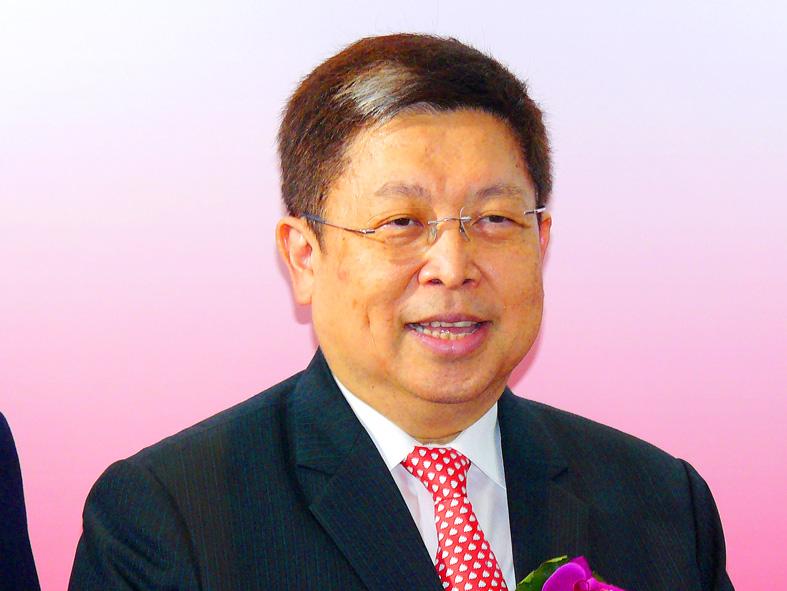Memory module supplier Adata Technology Co (威剛科技) yesterday said that contract prices for NAND flash memory are expected to rebound this quarter, following an uptrend in DRAM prices.
However, supply constraints would carry into next quarter, as recovering demand from automakers adds pressure to an industry beset by strong demand for notebook computers, smartphones and data centers, Adata said.
DRAM prices are expected to climb steadily after a trough at the beginning of December last year, with more marked hikes next quarter, Adata chairman Simon Chen (陳立白) said.

Photo: CNA
A severe supply crunch is expected in the second half of this year, Chen said.
The company, which is based in New Taipei City’s Sindian District (新店), said that it has built at least two months of DRAM chip inventory for its own use.
Adata’s financial performance this quarter would be significantly better than last quarter, Chen said.
Higher shipments of solid-state drives (SSD) have helped, he said.
The company’s revenue for last month grew 12.27 percent to NT$2.81 billion (US$99.41 million), compared with NT$2.5 billion in February last year, aided by a rise in DRAM prices and improved demand for NAND memory chips for SSD storage, Adata said in a statement.
On a monthly basis, revenue fell 4 percent from NT$2.93 billion.
DRAM products accounted for about 40 percent of the company’s total revenue last month, SSD products contributed 42 percent, and memory cards, flash drives and other items made up 16 percent, it said.
“Since the beginning of this year, customers have been placing orders aggressively,” Adata said. “Employees worked overtime during the Lunar New Year holiday to satisfy demand.”
The company said that it is bullish about this year’s business outlook, citing robust demand.
In the first two months of this year, revenue jumped 32.26 percent to NT$5.74 billion from NT$4.34 billion in the same period last year.
DRAM chipmaker Nanya Technology Corp (南亞科技) on Wednesday reported that last month’s revenue was its highest in 28 months, driven by higher prices.
Revenue rose 26.91 percent to NT$5.79 billion, from NT$4.56 billion in February last year, and grew 4.68 percent from NT$5.53 billion in January, Nanya said.
Nanya president Lee Pei-ing (李培瑛) in January said that he expected a DRAM price uptrend to continue throughout the first half of this year, and it might extend into the second half as the COVID-19 pandemic-driven stay-at-home economy, as well as a chip shortage, boosts DRAM consumption for notebook computers, tablets, networking devices and game consoles.

TAKING STOCK: A Taiwanese cookware firm in Vietnam urged customers to assess inventory or place orders early so shipments can reach the US while tariffs are paused Taiwanese businesses in Vietnam are exploring alternatives after the White House imposed a 46 percent import duty on Vietnamese goods, following US President Donald Trump’s announcement of “reciprocal” tariffs on the US’ trading partners. Lo Shih-liang (羅世良), chairman of Brico Industry Co (裕茂工業), a Taiwanese company that manufactures cast iron cookware and stove components in Vietnam, said that more than 40 percent of his business was tied to the US market, describing the constant US policy shifts as an emotional roller coaster. “I work during the day and stay up all night watching the news. I’ve been following US news until 3am

UNCERTAINTY: Innolux activated a stringent supply chain management mechanism, as it did during the COVID-19 pandemic, to ensure optimal inventory levels for customers Flat-panel display makers AUO Corp (友達) and Innolux Corp (群創) yesterday said that about 12 to 20 percent of their display business is at risk of potential US tariffs and that they would relocate production or shipment destinations to mitigate the levies’ effects. US tariffs would have a direct impact of US$200 million on AUO’s revenue, company chairman Paul Peng (彭雙浪) told reporters on the sidelines of the Touch Taiwan trade show in Taipei yesterday. That would make up about 12 percent of the company’s overall revenue. To cope with the tariff uncertainty, AUO plans to allocate its production to manufacturing facilities in

Six years ago, LVMH’s billionaire CEO Bernard Arnault and US President Donald Trump cut the blue ribbon on a factory in rural Texas that would make designer handbags for Louis Vuitton, one of the world’s best-known luxury brands. However, since the high-profile opening, the factory has faced a host of problems limiting production, 11 former Louis Vuitton employees said. The site has consistently ranked among the worst-performing for Louis Vuitton globally, “significantly” underperforming other facilities, said three former Louis Vuitton workers and a senior industry source, who cited internal rankings shared with staff. The plant’s problems — which have not

COLLABORATION: Given Taiwan’s key position in global supply chains, the US firm is discussing strategies with local partners and clients to deal with global uncertainties Advanced Micro Devices Inc (AMD) yesterday said it is meeting with local ecosystem partners, including Taiwan Semiconductor Manufacturing Co (TSMC, 台積電), to discuss strategies, including long-term manufacturing, to navigate uncertainties such as US tariffs, as Taiwan occupies an important position in global supply chains. AMD chief executive officer Lisa Su (蘇姿丰) told reporters that Taiwan is an important part of the chip designer’s ecosystem and she is discussing with partners and customers in Taiwan to forge strong collaborations on different areas during this critical period. AMD has just become the first artificial-intelligence (AI) server chip customer of TSMC to utilize its advanced